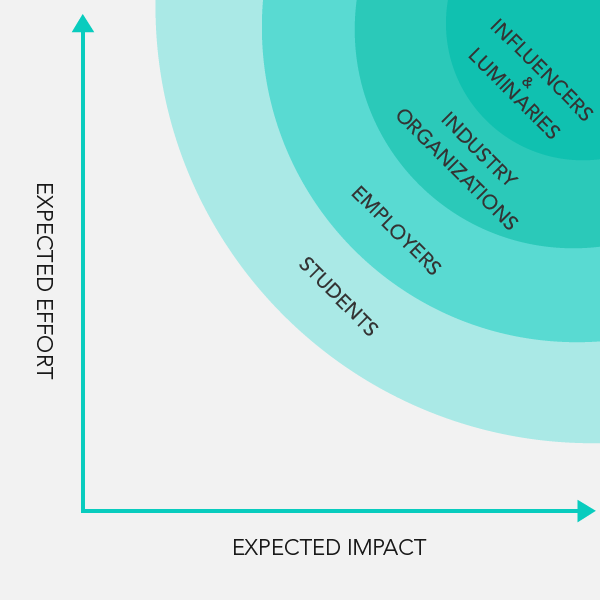One of the unique features of competency-based education (CBE) is its ability to offer market-ready academic programs in high demand disciplines that are readily aligned to specific industry needs. Over time, however, this presents a grave vulnerability in this market. The more industry-focused certain programs become (which many institutions moving into this space increasingly aspire to), the more beholden these programs are to trends and innovations in the industries they serve. To ensure their long-term relevance and scalability, these programs need to be designed with thorough and comprehensive industry input.
From our research, we find a growing number of forward-looking institutions in CBE, including Southern New Hampshire University, Arizona State University, and Purdue University. These institutions are staying well ahead of this challenge, in part by implementing strategic knowledge sharing partnerships with key voices in an industry.

Basic Strategy
In this process, an institution actively and aggressively pursues partners and solicits their input, both at the outset of program design and as a critical component of program improvement. This process values partners’ awareness of the needs, trends, and transformations within an industry to better adapt programs to changes over time. Target partners might include:- Students, or employees of a particular employer, who are keenly aware of what they need in order to succeed in their job and to advance in their careers.
- Employers, including hiring managers and supervisors, who offer insight into how to better align academic programs with their complex and changing needs.
- Industry groups and advocacy organizations, including foundations, networks, career clusters, and advocacy groups, who, by virtue of their more elevated position, represent larger networks of employees and employers.
- Influencers and luminaries, who hold the unique ability not only to comment on industry needs, but also to anticipate changes, in large part because they also help shape them.
Effort and Impact
Keep in mind that forging knowledge-sharing partnerships usually comes with varying degrees of effort and impact, depending on a partner’s position within an industry. Employees are obviously the easiest to engage, given their existing connection to your institution, but are usually only valuable for understanding short-term demand. Employers, industry groups, and advocacy organizations are harder to engage, but tend to have a longer-term view and are therefore useful for anticipating changes. Influencers and luminaries (think Starbucks CEO Howard Shultz) are the most difficult to engage, but also the most forward looking and, thus, by far the most impactful to your strategy.
Getting Started with Knowledge Sharing Partnerships
Stating the benefits of these partnerships is one thing. Actually forging them and making them meaningful is another. Here are some recommendations for getting started with this process:- Task a team with carrying out a partnership engagement plan. Institutions with successful CBE programs have teams of people devoted to building and sustaining partnerships, often through this type of knowledge sharing process, and governed by a clear set of priorities and expectations. If you have not already, form a team that is tasked with thinking creatively and strategically about different partnerships and with drafting a plan to guide your strategy forward.
- Create mechanisms to solicit partners’ input. Establish the necessary lines of communication between your institution and your partners. These may include simple tactics such as fielding regular surveys, hosting focus groups, and informal and formal conversations, either in person or virtually. A more complex tactic would be to conduct sophisticated market research (e.g., using labor metrics or insights from ethnographic research) to better anticipate partners’ needs and then solicit your partners’ input into the plausibility and usefulness of these insights.
- Work backwards and look ahead. As you engage with partners in this way, listen and learn. From there, apply their input and expectations to develop your programs and make improvements based only on what you glean from your partners over time. This “backward design” process, based on what partners say they need rather than what you think they need, will ensure the responsive evolution of your CBE programs moving forward.

